
 |
|||||||||||||||||||
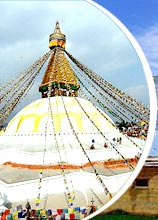 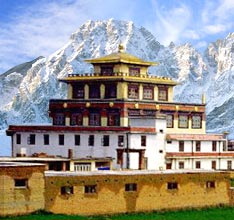 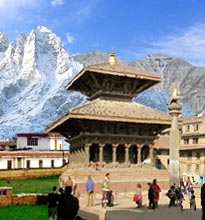 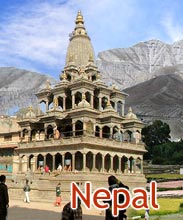 |
|
|
|
Swayambhunath Stupa
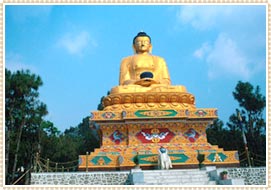 Swayambhunath
Stupa or The Stupa with golden spire is a 5th-century pagoda in Nepal.
Typical of other monasteries, the Swayambhunath Stupa is adorned with
fluttering prayer flags. This UNESCO Heritage site is situated on a hill
that overlooks the Kathmandu valley and can be clearly seen from any
part of Kathmandu on a clear weather day. In fact it can be safely
adjudged as the most recognizable monument in entire Kathmandu. The
golden top of the pagoda and the "Eyes of Buddha" that has
been painted on it can be easily recognized from anywhere in Kathmandu. Swayambhunath
Stupa or The Stupa with golden spire is a 5th-century pagoda in Nepal.
Typical of other monasteries, the Swayambhunath Stupa is adorned with
fluttering prayer flags. This UNESCO Heritage site is situated on a hill
that overlooks the Kathmandu valley and can be clearly seen from any
part of Kathmandu on a clear weather day. In fact it can be safely
adjudged as the most recognizable monument in entire Kathmandu. The
golden top of the pagoda and the "Eyes of Buddha" that has
been painted on it can be easily recognized from anywhere in Kathmandu.Swayambhunath is one of the holiest Buddhist site in entire Nepal. The Stupa is also connected to the legend that surrounds the birth of Kathmandu. It is said that when the ancient lake was drained out to form the Kathmandu valley, the shining sunlight became Swyambhunath Stupa. On a regular day, you will find various groups of Buddhist monks, dressed in maroon, circling the complex. Every one of them will have the sacred prayer wheels in their hand unless they have not caught the fancies of scores of monkeys that inhabit the area. These irrelevant groups of monkeys play prank with tourists and monk and thus this shrine has been re-christened, Monkey Temple. Hindus, Vajrayana Buddhists of northern Nepal and Tibet, and the Newari Buddhists of central Nepal worship Swayambhunath. The daily prayer starts early morning and that is the best time to visit this site. Monks scale this 365 stairs building and begin a series of clockwise circumambulations of the Stupa. Hindus and Newari Buddhists prefer counter-clockwise direction. "The eyes of Buddha" are on all four sides. They symbolizes that God is omnipresent. Above each pair of eyes is a third eye that signifies the wisdom of looking within. There are no ears because it is said the Buddha is not interested in hearing prayers in praise of him. |
 Taj Mahal Tour Taj Mahal Tour Rajasthan Tours Rajasthan Tours Kerala Tours Kerala Tours Kashmir Tours Kashmir Tours Tamilnadu Tours Tamilnadu Tours Adventure Tours India Adventure Tours India Beach Tours India Beach Tours India Desert Tours India Desert Tours India Pilgrimage Tours India Pilgrimage Tours India Ayurveda Tours India Ayurveda Tours India Buddhist Tours India Buddhist Tours India Temple
Tours India Temple
Tours India Sculpture Tours India Sculpture Tours India Golden Triangle Tour Golden Triangle Tour India Heritage Tours India Heritage Tours Hill Tours India Hill Tours India Honeymoon Tours India Honeymoon Tours India Kerala Backwaters Tour Kerala Backwaters Tour India Train Tours India Train Tours Trekking Tours India Trekking Tours India India Wildlife Tours India Wildlife Tours Karnataka Tour Karnataka Tour Nepal Tour Nepal Tour Orissa Tour Orissa Tour Gujarat Tour Gujarat Tour Andhra Pradesh Tour Andhra Pradesh Tour Maharashtra Tour Maharashtra Tour Chardham Tour Chardham Tour  Golden Chariot Golden Chariot Himachal Pradesh Tour Himachal Pradesh Tour Sikkim Tour Sikkim Tour Madhya Pradesh Tour Madhya Pradesh Tour
|
||||||||||||||||||||||||||||
| |||||||||||
Copyright © BharatOnline.com | |||||||||||